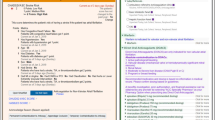ABSTRACT
BACKGROUND
As electronic health records (EHRs) become widely adopted, alerts and reminders can improve medication safety, but excessive alerts may irritate or overwhelm clinicians, thereby reducing their effectiveness. We developed a novel “stealth” alert in an EHR to improve anticoagulation monitoring for patients prescribed a medication that could interact with warfarin. Instead of alerting the prescribing provider, the system notified a multidisciplinary anticoagulation management service, so that the prescribing clinicians never saw the alerts. We aimed to determine whether these “stealth” alerts increased the frequency of anticoagulation monitoring following the co-prescription of warfarin and a potentially interacting medication.
METHODS
We conducted a pre-post intervention study, analyzed using an interrupted time-series, within a large, multispecialty group practice that uses a common EHR. The study included a 12-month period preceding the intervention, a 2-month period during intervention implementation, and a 6-month post-intervention period. The primary outcome measure was the proportion of patients completing anticoagulation monitoring within 5 days of a new co-prescribing event.
RESULTS
Prior to implementation of the stealth alert, 34 % of patients completed anticoagulation monitoring within 5 days after the prescription of a medication with a potential warfarin interaction. After implementation of the alert, 39 % completed testing within 5 days (odds ratio 1.24, 95 % confidence interval 1.12–1.37).
CONCLUSIONS
Stealth alerts increased the proportion of patients who underwent anticoagulation monitoring following the prescription of a medication that could potentially interact with warfarin. This team-based approach to clinical-decision support directs alerts away from prescribing clinicians and toward individuals who can directly implement them.


Similar content being viewed by others
REFERENCES
Feldstein AC, Smith DH, Perrin N, et al. Reducing warfarin medication interactions: an interrupted time series evaluation. Arch Intern Med. 2006;166:1009–15.
Kesselheim AS, Cresswell K, Phansalkar S, Bates DW, Sheikh A. Clinical decision support systems could be modified to reduce 'alert fatigue' while still minimizing the risk of litigation. Health Aff (Millwood). 2011;30:2310–7.
van der Sijs H, Aarts J, Vulto A, Berg M. Overriding of drug safety alerts in computerized physician order entry. J Am Med Inform Assoc. 2006;13:138–47.
Kuperman GJ, Bobb A, Payne TH, Avery AJ, Gandhi TK, Burns G, et al. Medication-related clinical decision support in computerized provider order entry systems: a review. J Am Med Inform Assoc. 2007;14:29–40.
Budnitz DS, Lovegrove MC, Shehab N, Richards CL. Emergency hospitalizations for adverse drug events in older Americans. N Engl J Med. 2011;365:2002–12.
Ansell J, Hirsh J, Hylek E, Jacobson A, Crowther M, Palareti G. Pharmacology and management of the vitamin K antagonists: American College of Chest Physicians evidence-based clinical practice guidelines (8th Edition). Chest. 2008;133:160S–98S.
Harvard Vanguard Medical Associates. Available at: www.harvardvanguard.org. Accessed April 22, 2012.
Epic® Systems. Available at: www.epic.com. Accessed April 22, 2012.
Collett D. Modeling survival data in medical research. Boca Raton: CRC Press; 1999.
Hosmer DW, Lemeshow S. Extensions of the Proportional Hazards Model. In: Applied Survival Analysis. NY: John Wiley & Sons; 1999.
Lee EW, Wei LJ, Amato DA. Cox-type regression analysis for large numbers of small groups of correlated failure time observations. In: Klein JP, Goel PK, eds. Survival analysis: state of the art. Netherlands: Kluwer Academic; 1992:237–47.
Wagner AK, Soumerai SB, Zhang F, Ross-Degnan D. Segmented regression analysis of interrupted time series studies in medication use research. J Clin Pharm Ther. 2002;27:299–309.
Schedlbauer A, Prasad V, Mulvaney C, et al. What evidence supports the use of computerized alerts and prompts to improve clinicians' prescribing behavior? J Am Med Inform Assoc. 2009;16:531–8.
Galanter WL, Didomenico RJ, Polikaitis A. A trial of automated decision support alerts for contraindicated medications using computerized physician order entry. J Am Med Inform Assoc. 2005;12:269–74.
Hayward GL, Parnes AJ, Simon SR. Using health information technology to improve drug monitoring: a systematic review. Pharmacoepidemiol Drug Saf. 2009;18:1232–7.
Fischer SH, Tija J, Field TS. Impact of health information technology interventions to improve medication laboratory monitoring for ambulatory patients: a systematic review. J Am Med Inform Assoc. 2010;17:631–6.
Avery AJ, Savelyich BS, Sheikh A, et al. Identifying and establishing consensus on the most important safety features of GP computer systems: e-Delphi study. Inform Prim Care. 2005;13:3–12.
Shah NR, Seger AC, Seger DL, et al. Improving acceptance of computerized prescribing alerts in ambulatory care. J Am Med Inform Assoc. 2006;13:5–11.
Feldstein A, Simon SR, Schneider J, et al. How to design computerized alerts to safe prescribing practices. Jt Comm J Qual Saf. 2004;30:602–13.
Rudd KM, Dier JG. Comparison of two different models of anticoagulation management services with usual medical care. Pharmacotherapy. 2010;30:330–8.
Stange KC, Nutting PA, Miller WL. Defining and measuring the patient-centered medical home. J Gen Intern Med. 2010;25:601–12.
Feldstein AC, Smith DH, Perrin N, et al. Improved therapeutic monitoring with several interventions: a randomized trial. Arch Intern Med. 2006;166:1848–54.
Freudenheim M. Digitizing Health Records, Before It Was Cool. New York Times. January 14, 2012. Available at: http://www.nytimes.com/2012/01/15/business/epic-systems-digitizing-health-records-before-it-was-cool.html?pagewanted=all. Accessed April 22, 2012.
CCHIT Certified® 2011. Available at: http://www.cchit.org/get_certified/cchit-certified-2011. Accessed: April 22, 2012.
Acknowledgements
Contributors
The authors thank Megan McNeill for assistance with the preparation of the manuscript.
Prior Presentation
None.
Funding/Support
Dr. Simon is a core investigator in the Center for Education and Research on Therapeutics: Health Information Technology, funded by the Agency for Healthcare Research and Quality.
Role of the Sponsor
The Agency for Healthcare Research and Quality had no role in the design and conduct of the study; collection, management, analysis, and interpretation of the data; and preparation, review, or approval of the manuscript. The content is solely the responsibility of the authors and does not necessarily represent the official views of the Agency for Healthcare Research and Quality.
Financial Disclosure
Nothing to disclose.
Conflicts of Interest
The authors declare that they do not have a conflict of interest.
Author information
Authors and Affiliations
Corresponding author
Rights and permissions
About this article
Cite this article
Koplan, K.E., Brush, A.D., Packer, M.S. et al. “Stealth” Alerts to Improve Warfarin Monitoring When Initiating Interacting Medications. J GEN INTERN MED 27, 1666–1673 (2012). https://doi.org/10.1007/s11606-012-2137-y
Received:
Revised:
Accepted:
Published:
Issue Date:
DOI: https://doi.org/10.1007/s11606-012-2137-y




